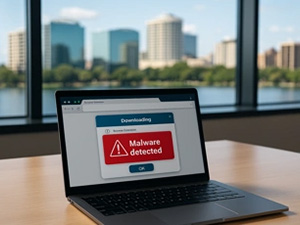
By Roy Richardson, Chief Security Officer, Aurora InfoTech
In 2025, over 2.3 million users downloaded browser extensions that were later discovered to be malware. These tools, disguised as productivity enhancers, were available through trusted platforms like Google and Microsoft. For many organizations, this incident flew under the radar. But for business leaders, it should be a powerful reminder: trusting the wrong technology can quietly open the door to serious risk.
This wasn’t just a technical failure. It was a breakdown in visibility, governance, and digital trust that exposed sensitive data, compromised credentials, and created ripple effects across supply chains. And it’s not an isolated event. It’s part of a broader trend that’s reshaping the Cybersecurity landscape.
The Rise of Infostealers: A Growing Threat to Business Integrity
Huntress reports that infostealer malware, which is designed to quietly extract login credentials, browser data, and sensitive files, surged by 180% in 2025. These threats are increasingly embedded in everyday tools like browser extensions, making them harder to detect and easier to deploy at scale.
Once inside your environment, infostealers don’t just steal data; they undermine the foundation of digital trust. They enable follow-on attacks like ransomware, business email compromise (BEC), and financial fraud without triggering traditional alarms.
The Hidden Risk of Shadow IT
One of the most overlooked risks in modern businesses is shadow IT, which occurs when employees install unapproved tools or software without IT’s knowledge. Browser extensions are a prime example. They’re easy to install, rarely monitored, and often granted broad access to systems and data.
From a business perspective, this creates a compliance and liability gap. If a breach occurs due to an unapproved extension, the organization, not the employee, bears the responsibility. The cost isn’t just technical. It’s financial, reputational, and legal.
Why Platform Trust Isn’t Enough
The fact that these malicious extensions were hosted on Google and Microsoft’s official stores is a wake-up call. Even trusted platforms can be exploited. This is a form of supply chain compromise, where attackers infiltrate through third-party tools and services that businesses rely on daily.
We’ve seen this before with the SolarWinds breach, the 3CX compromise, and the MOVEit data breach. The lesson is clear: trusting the supply chain without verifying it is no longer a viable strategy.
Zero Trust: A Smarter Way to Manage Risk
To protect against these evolving threats, more organizations are adopting a Zero Trust approach. At its core, Zero Trust means “never trust, always verify.” It flips the traditional model of “trust but verify” on its head.
Instead of assuming that users, devices, or applications are safe just because they’re inside your network, Zero Trust requires continuous validation. It’s a mindset shift from perimeter defense to risk-based access control.
Two effective security controls that support this model are:
- Application Allowlisting functions like a guest list for your computer. Only software that has been pre-approved is permitted to run. Any other applications, such as unknown programs, suspicious downloads, or hidden malware, are automatically blocked. This process helps keep your systems secure by ensuring that only trusted programs can operate.
- Ringfencing™ establishes strict boundaries on what approved applications can do. For instance, it can prevent a program like Microsoft Word from opening other applications, accessing sensitive files, or accessing external websites unless such actions are explicitly allowed. This measure helps stop cybercriminals from exploiting common tools in harmful ways.
These controls help businesses contain threats before they escalate, without disrupting productivity.
The Business Impact: What’s at Stake
According to IBM’s 2024 Cost of a Data Breach Report, the average breach now costs $4.88 million. Breaches involving shadow IT or unapproved software are even more expensive—and harder to detect. Meanwhile, cyber insurance providers are tightening their policies, often excluding coverage for incidents involving negligent practices or unapproved tools.
For business leaders, this isn’t just an IT issue. It’s a board-level risk that affects financial performance, regulatory compliance, and brand reputation.
What Business Leaders Should Do Now
To reduce exposure and strengthen resilience, here are five strategic actions to consider:
- Gain visibility into all software and browser extensions running in your environment.
- Adopt a Zero Trust model that includes application allowlisting and Ringfencing™.
- Educate employees on the risks of unapproved tools and how to report suspicious activity.
- Review your cyber liability insurance to ensure it aligns with your actual risk profile.
- Conduct regular security assessments that include shadow IT and third-party tools.
Final Thought: Trust Is Not a Control—It’s a Risk
The browser extension incident is not an anomaly. It’s a symptom of a larger issue: overreliance on platform trust, underinvestment in user awareness, and lack of visibility into the tools employees use every day.
As business leaders, we must move beyond reactive security and embrace a risk-informed, trust-minimized approach to digital operations. Because in today’s threat landscape, what you don’t see can—and will—hurt you.
Let’s Keep the Conversation Going
If this incident has prompted you to reflect on your organization’s cyber readiness, now is the time to engage your leadership team in a meaningful dialogue. Are your insider threat defenses truly effective? How confident are you in the security posture of your vendors and third-party tools? When did your team last run a tabletop exercise to simulate a real-world Cybersecurity incident?
Cybersecurity is no longer just an IT concern—it’s a shared business responsibility. It starts with awareness, alignment, and action at the executive level.
If you're looking to strengthen your organization’s resilience, schedule a discovery call to explore how our Cyber Liability Management programs and proactive risk mitigation strategies can support your security goals.









